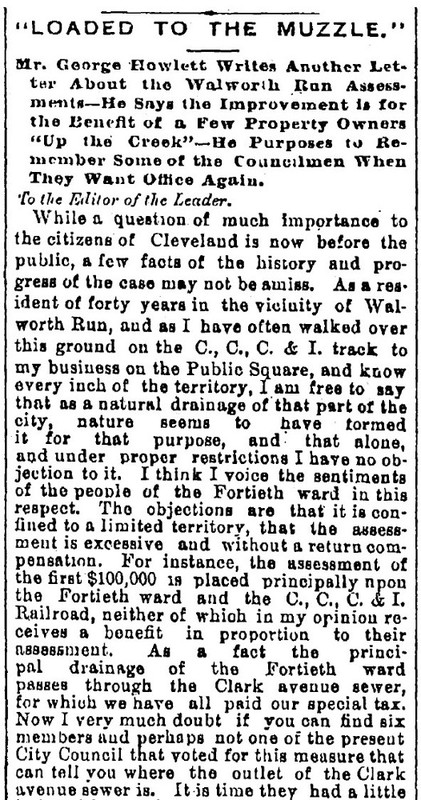William Burton House
The historic West Side house that changed as its owners changed

In his book "How Buildings Learn: What Happens After They're Built," Stewart Brand explores the relationship between people and the structures they create. Referring to Winston Churchill's statement that "We shape our buildings, and afterwards our buildings shape us," Brand writes that Churchill almost got it right. More accurately, says Brand, "First we shape our buildings, then they shape us, then we shape them again--ad infinitum. Function reforms form, perpetually."
The Burton House at 2678 West 41st Street illustrates Brand's point almost perfectly. Built in 1839 by William Burton, a ship captain from Vermont and early Ohio City pioneer, it is one of the oldest, if not the oldest, homes in Cleveland's Clark-Fulton neighborhood. In the 175 years of its existence, it has changed from elitist country home to middle-class neighborhood home to working class residence in a struggling community and, now, to abandoned home in a neighborhood that is perhaps on its way to rebirth. And along the way, the house has shaped the lives of all of the people who have owned and lived in it, just as they have shaped and reshaped it.
Originally located on thirty acres of land just south of Walworth Run in what was at the time Brooklyn Township, the house was once referred to by Burton's mother-in-law as his "Ohio City cottage." While it is a small house by mansion standards, it was clearly designed for upper class living. When first occupied, it had a large parlor and dining room on the first floor with nearby servant's quarters which had easy access to those two rooms, as well as to the pantry and small servant's kitchen. On the second floor were the family bedrooms. The house was nestled among vineyards and apple, peach and other fruit trees.
Change came to the house in 1854 when Burton sold most of his thirty acres of land to Hiram Stone, a local land developer. Stone incorporated the house into a large residential subdivision that he was building and named the county road upon which the house sat "Burton Street" for William Burton. Stone's subdivision would soon become the newest addition to Cleveland's south side.
In 1861, English immigrant George Howlett bought the Burton House which now sat on an approximately one-half acre parcel of land, but still had almost 130 feet of frontage on Burton (today, West 41st) Street. Howlett saw the neighborhood changing as German and Bohemian immigrants moved in and as industry sprung up along the Walworth Run. He responded by changing the house. He removed the house's south wing and subdivided the land upon which the house sat into five lots and an alley, leaving the now less grand-looking Burton House sitting on a thirty-three foot wide strip of land sandwiched between and dwarfed by two newer houses that were built closer to the street. He also relocated and enlarged what was now a family kitchen, built a cellar, and added a storage shed and lean to to the back of the house. When, after almost four decades of ownership, the Howlett family sold the Burton House in 1899, it no longer was that original elitist country home. It had become, like its most recent owner, middle class.
The process of owners changing the Burton house, and the Burton house changing owners, continued into and through the next century. In the early twentieth century, the home was first owned by a family who added an indoor bathroom-- that new century convenience, and removed the shed and lean to, presumably to make room on the property for another new century convenience, the automobile.
The twentieth century also brought a wave of new immigrants to Cleveland and to the Clark-Fulton neighborhood. Along the Fulton Road corridor, an Italian community grew, which, in 1915, founded St. Rocco parish. In 1944, the Burton House was acquired by an Italian family who owned and lived in it for most of the remainder of the century. As Cleveland experienced decline in the second half of the century, so did the Clark-Fulton neighborhood, and so did the Burton House. Now located in a working class neighborhood, the house again changed with its new owners. Another bathroom was added. The servant's quarters became family bedrooms. The pass-through from the pantry to dining room was plastered over. Upstairs bedrooms were rented out to boarders to help make ends meet.
With help from Cleveland's Department of Community Development in the 1980s, the Burton House was maintained in livable condition until it was sold in 1997. After that, it rapidly deteriorated. Its beautiful exterior French doors were removed and sold. So was the chandelier which once adorned the dining room. The late Cleveland Municipal Court Judge Ray Pianka spent countless hours working with Clark-Fulton neighborhood community leaders in a never-give-up effort to save the house. While regrettably he did not live to see it happen, the William Burton House was eventually rescued, renovated and restored in 2021. In less than two decades, this historic house will celebrate its 200th anniversary on West 41st Street.
Images













